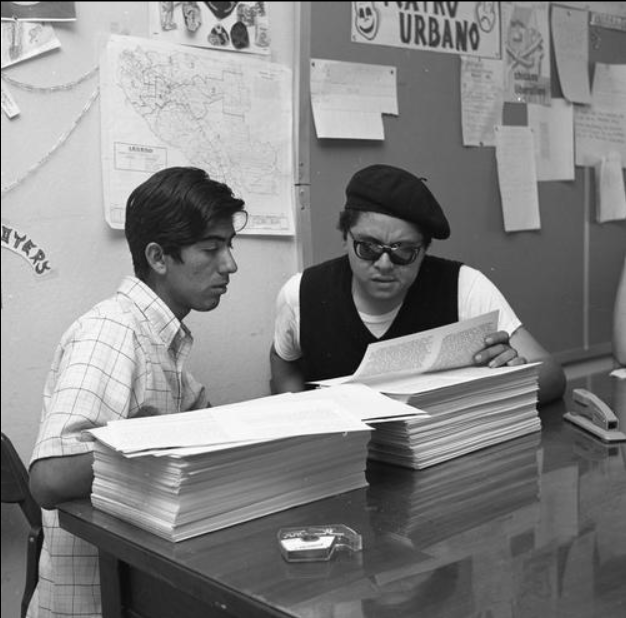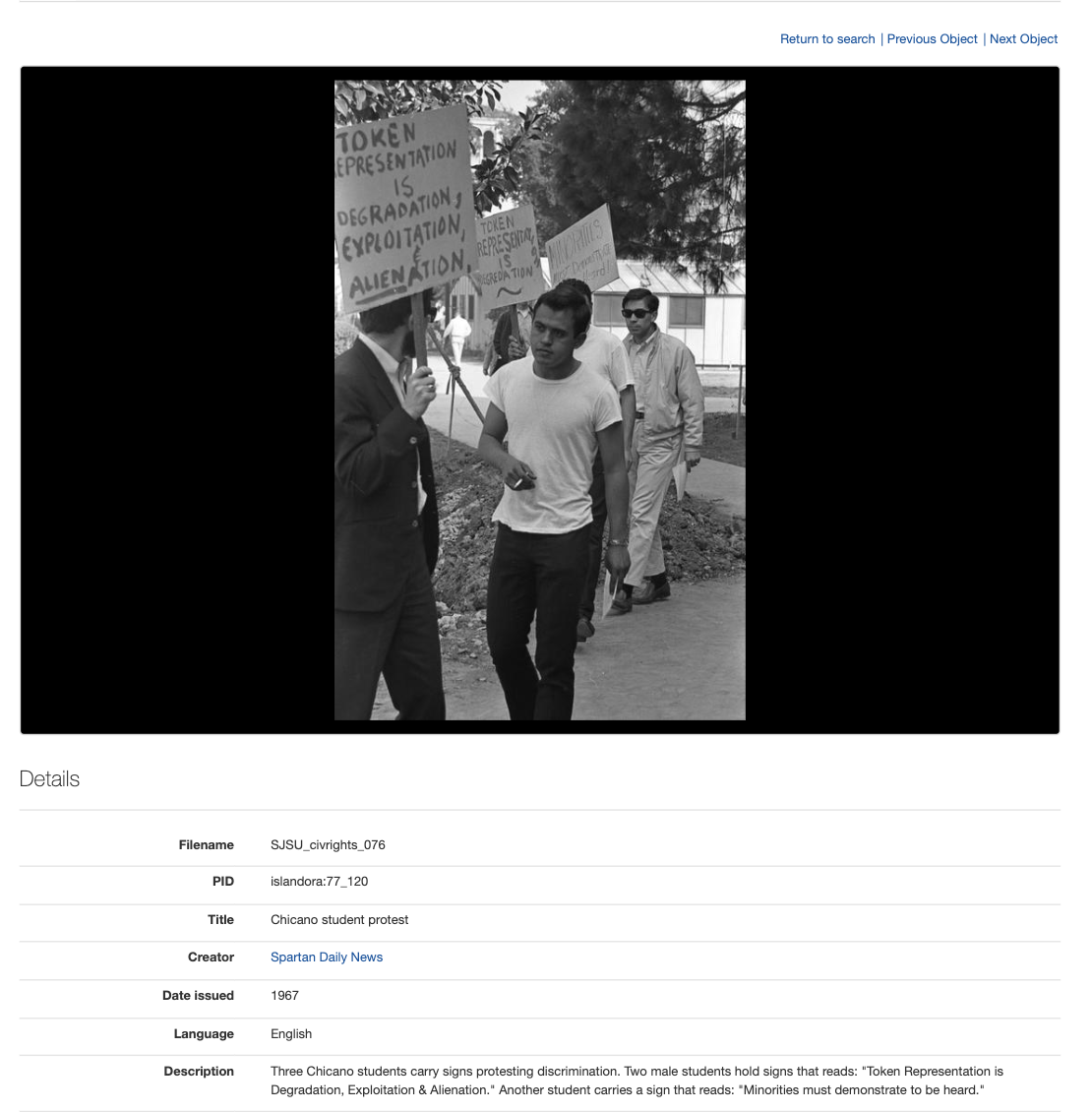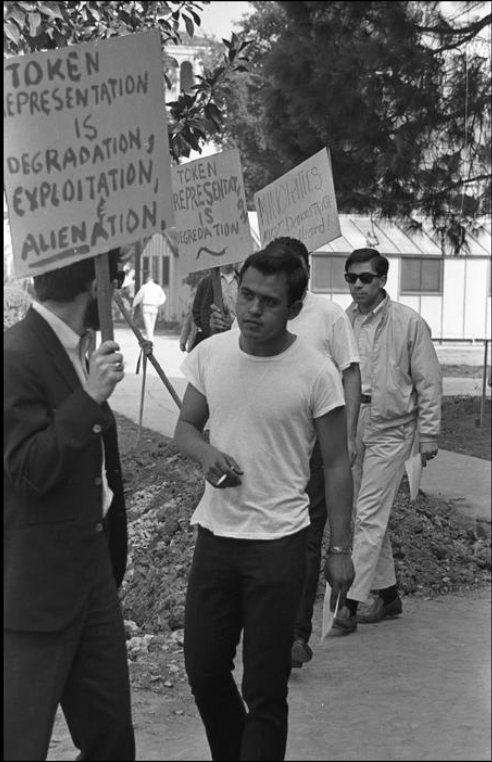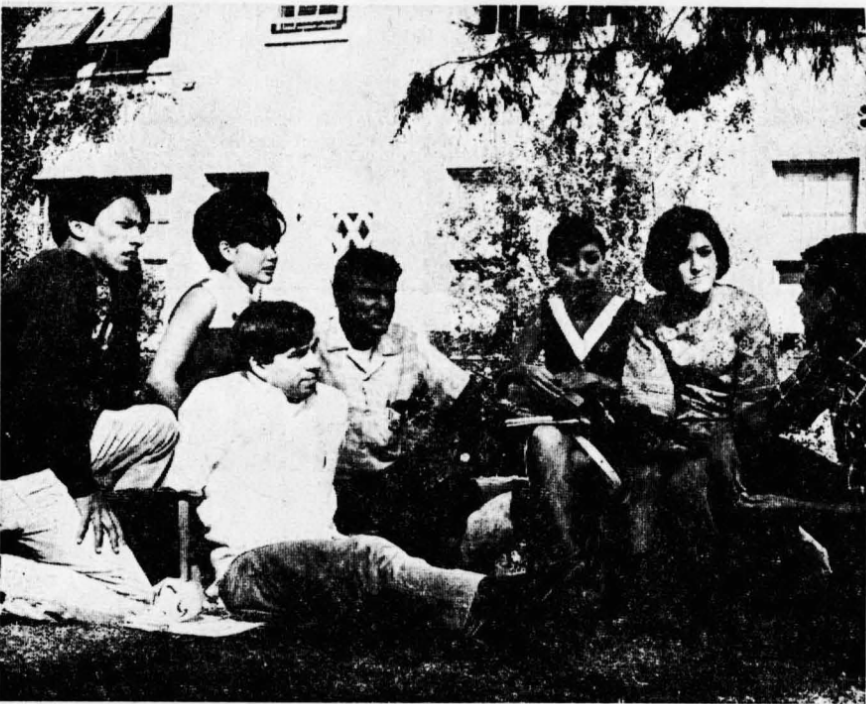The main goals of our project are giving credit to student activists for their tireless work and ensuring that their names are part of the historical record of activism at San José State.
These goals were formulated early on in the project when we discovered that digitized photos in the “SJSU Civil Rights Campus Protest Collection” archive had vague photo titles, descriptions, and metadata with few student activists identified. The lack of preservation of specific and accurate photo data captures the suppression of Civil Rights era student activism history that has taken place over time, a process of historical erasure that obscures the names of student activists in official campus records.
Through archival research and oral history interviews, we made it our mission to research and identify:
- the names of the student activists who appear in each photo
- the locations and dates of the photos
- what student groups, labor, and events are captured
Below we present a sample of side-by-side comparisons. On the left, we share screenshots of vaguely written SJSU Civil Rights and Campus Protest Collection photo titles and descriptions. On the right, we share what the March With Us! project team’s research has revealed about each photo. For each photo, our description specifically and accurately credits the Chicano movement student activists at San José State who so powerfully shaped SJSU’s past, present, and future.
SJSU Photo Description 1:
“Chicano Students”

SJSU’s Official Description: View of three Chicano students listening to an obscured speaker. (screenshot of website)
March With Us! project Research and Metadata Update:

March With Us! Photo Description: Tino Esparza, Ben Ibarra, and Dan Hernandez, members of Mexican American Student Confederation, meet to discus plans to demonstrate at San Jose State’s June 14, 1968 commencement ceremony. Their walkout at the 1968 graduation ceremony and subsequent celebratory festivities on 7th Street would lead to an enduring tradition at San Jose State today, the Chicano Commencement Ceremony. Photo by Dennis Dougherty for Spartan Daily.
Source:
Contextualizing Images
Photo captions in official archival records are meant to be concise, but object descriptions can capture greater context. The official record for most objects in the SJSU Civil Rights and Campus Protest Collection provides very basic information, often missing important contextual data that was not collected or preserved, which obscures the social, cultural, or historical importance of the photos.
SJSU Archive Photo Description 2: “Chicano Students”

SJSU’s Official Description: Two Chicano students review a stack of papers. The student on the left is Rudy Madrid.
Image credit: Object record screenshot, 2023.
March With Us! project Research and Metadata Updates:

March With Us! Photo Description: Rudy Madrid (L) who would later become president of United People Arriba (UPA), tutors a student in the Educational Opportunity Program office located at the corner of 9th Street and San Carlos. Minority students fought for an EOP program to help students of color receive educational, financial, and social support. Due to student activists’ labor, San Jose State was the first university to have such a program, and many universities thereafter asked for advice on how to start one at their own campus.
Missing the Big Picture
It is troubling when official public archive descriptions are created without knowing the who, what, where, or why of photos documenting political dissent and student activism. Taking an image too literally or not fully understanding what is taking place can perpetuate misunderstanding. For the official SJSU archival object record below, the description inaccurately transcribes the sign captured in the photo as stating “Viva… USA.” The accurate transcription is “Viva La Causa,” one of the most important and common phrases used by the Chicano movement nationally. “Viva La Causa” means “Long Live the Cause” and was a the motto of the National Farm Workers Association (NFWA). Its use in a Chicano student action at San José State is significant for recognizing how Chicano student groups communicated specific demands for change in higher education while also expressing their solidarity with NFWA.
SJSU Archive Photo Description 3:
Chicano student protest

SJSU’s Official Description: Chicano students protest racial discrimination, poverty, housing, and sports issues on campus. Behind the speaker a sign that reads: “Viva…USA.”
Image credit: Object record screenshot, 2023.
March With Us! project Research and Metadata Update:

March With Us! Photo Description: Al Espinoza, Spring 1967 Student Initiative president, and later, the first Chicano EOP director, holds a sign with “Viva La Causa” on it, a motto taken up by the National Farm Workers Association, an organization which many San Jose State Chicano activist groups were closely allied.
A Picture is Worth a Thousand Words
Correcting historical and archival records by helping identify specific events and activist names is crucial for crediting the voices behind of the movement that set San José State on the path to becoming one of California’s leading Hispanic Serving Institutions. While the below example of official records accurately transcribes the text of signs used in a campus demonstration, it does not identify and center the students involved in this specific action. The March With Us! example demonstrates the need to create a more robust and enduring educational resource that is committed to honoring student labor and voices.
SJSU Archive Photo Description 4: Chicano student protest

SJSU’s Official Description: Three Chicano students carry signs protesting discrimination. Two male students hold signs that read “Token Representation is Degradation, Exploitation & Alienation.” Another student carries a sign that reads: “Minorities must demonstrate to be heard.”
Image credit: Object record screenshot, 2023.
March With Us! project Research and Metadata Update:

March With Us! Photo Description: Armando Valdez, president of Student Initiative in 1967 (L), holds a sign that reads “Token representation is degradation, exploitation, & alienation” and speaks with Student Initiative members Rico Valdez (middle) and Carlos “Charlie” Chavez (R), as they and others demonstrate against Chicano exclusion from the “Dilemma of American Cities” program in front of Morris Dailey Auditorium on March 1, 1967. The “Dilemma of American Cities” program was aimed at helping solve issues for minorities in urban areas, but the committee to find speakers reached out to Chicano farm workers to be part of the panel, furthering the stereotype of Chicanos as laborers even though most Chicanos lived in cities. Photo by Fred Rosenberg for Spartan Daily.
Necessary Additions to the Archives
There are 10 photos of Chicano activism in the San Jose State Civil Rights and Campus Protest Collection. Only 10. That is not enough to show the many Chicano students who fought against structural racism, the breadth of issues Chicano groups championed, and what they were able to accomplish.
In research, having a small sample size may lead you to draw incorrect conclusions from the evidence. Your results might make you think that certain factors may be more important than they are, while underestimating the impact of others. Which is the case with these photos. There are no Chicanas in the Chicano activism photos. This could lead you to believe that they weren’t as involved in demonstrations as men. But of the movements we have researched, Chicano groups tended to not only have more women participating, but also had a more equal distribution of power and responsibilities among men and women.
None of those images depict the women of the Chicano Movement who led discussions, organized, and built connections to strengthen the movement. There are more photos of Chicana and Chicano activism out there, but there needs to be a more concerted effort to collect and preserve the history of these movements so that people looking back can see an accurate depiction of the many diverse groups agitating for change during the Civil Rights era. For that reason, the photo below is a recommendation for additions to the archives.

Photo Description: Members of Chicano group Student Initiative in the fall of 1967. Left to Right: SI President Juan Garcia, Rosalinda Martinez, Carlos “Charlie” Chavez (seated), Ben Ibarra, Connie Moralez, SI Vice President Norma Fierro, and Dan Hernandez, Spring 1968 Mexican American Student Confederation President. Student Initiative was one of the first Chicano groups at San Jose State. Their aim was to encourage Chicano high school students to attend college, provide support for current San Jose State students, and make connections with the local Chicano community. Photo by Mike Hoban for Spartan Daily.